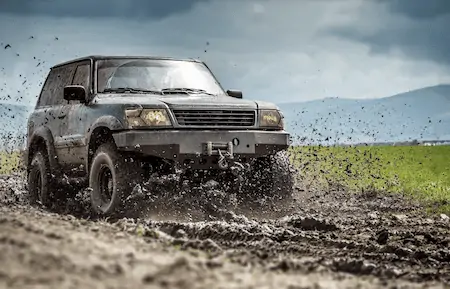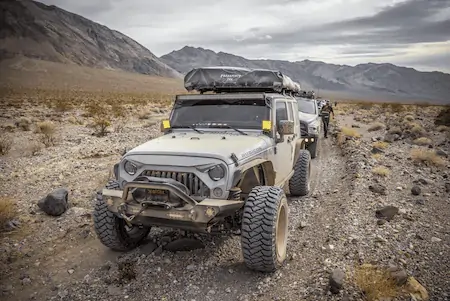More people discover off-roading as a form of relaxation and entertainment. This activity can be a lot of fun and exciting experience.
It’s where you can take your vehicle to the limit and beyond. Riding into unsurfaced tracks or roads such as mud, sand, rock, or riverbeds are some of the adventures that car enthusiasts love to do.
While this venture may seem challenging, it’s best to prepare your vehicle beforehand. Taking all the necessary precautions may prevent a car accident and ensure your safety.
This article will give helpful tips on preparing your vehicle to have safe and successful off-road driving.
5 Tips To Prepare Your Vehicle For Off-Road Driving
#1. Check Your Tires
The tires of an off-road vehicle are one of the most important things that need to be checked regularly. Not all tires are suitable for rough terrain, so it’d be best to have the correct tires to stand off-road driving conditions.
Here are some of the different types of off-road tires:
-
All-Terrain Tires
These are the most common type of off-road tires. They have a combination of open space and treads that can grip most surfaces, including gravel, sand, or even snow.
All-terrain tires have reinforced sidewalls that prevent damage from sharp rocks or other objects.
-
Mud Terrain Tires
If you want to drive through deep mud or soft dirt, this type of tire might be your best choice. It has large ribs or lugs that can dig deep into the ground, giving them more traction on slippery surfaces.
Mud terrain tires also have reinforced sidewalls with several plies, which means the tires won’t easily puncture or tear.
-
Snow Tires
Snow tires are similar to all-terrain tires, which have a large tread to maximize grip when driving in snow conditions.
They have deeper grooves than most off-road tires to channel away water. Snow tires are usually studded with steel or carbide tips that can provide better grip on icy tracks.
-
Rock Or Stone Tires
If you want to drive on rocky or sharp surfaces such as mountains, this type of tire can be your ideal option.
They often have big treads and a significant breaking point, minimizing damage from bumpy tracks. They also provide good braking performance and grip on slippery surfaces.
#2. Examine The Vehicle’s Brake System
This approach might be the most common type of truck accident. A brake failure may result in uncontrolled acceleration, which can cause the vehicle to lose its bearings and rollover.
Check if the brake system on your car is working correctly before drifting off-road to avoid catastrophe. It’s best to have your brake system checked to ensure adequate pressure.
You can also ask your mechanic to increase or decrease the brake fluid’s level just in case the brakes aren’t working as they should be.
When the brake fluid is low, the car’s braking system can fail while going through a complex track.
In case you get into a truck accident due to brake failure and sustained injuries, be sure to immediately contact a personal injury lawyer, says legal experts at The Pendergrass Law Firm. A lawyer will evaluate your case and see if you are eligible for compensation.
#3. Choose The Correct Gear
Choosing the right gear for off-road driving is also essential. It may help if you have adequate traction control to handle your vehicle better, even when the ground is wet or slippery.
Here are some important gears that you must check before venturing for off-road driving:
-
Transmission Oil
Assess your transmission oil level to see if it’s sufficient for off-road driving. If the transmission is running low on lubricant, this might cause problems during an intense journey.
You can check your car’s manual or consult with a mechanic about the right type and amount of transmission oil to use.
-
Differential Lube
Prepare enough differential lubricant before driving off-road. Check the differentials to see if they’re running low on gear oil.
If no gear oil is left, it might cause your wheels to lock up and may cause accidents or mishaps. You should also check the vehicle’s manual about recommended types of lubricants to use.
-
Lift Kit Or Body Lift Kit
If you want to drive off-road at higher elevations, you might need a lift kit or a body lift kit for your vehicle.
Lift kits and body lifts can raise the car’s chassis above ground to ensure there’s enough clearance when going through complex tracks.
-
Extra Lighting
Like on regular roads, you also need to have extra lighting when you drive at night or in adverse weather conditions.
It’s best to ensure there are enough lights you can use as a backup if the power of your main lamps goes out.
For instance, you can have auxiliary lamps, fog lights, or even off-road spotlights on your car. Doing so will keep you safer when driving at night, so you can navigate the road even if it’s poorly lit or covered in fog.
#4. Inspect The Battery
Your car’s battery is vital in ensuring enough power for your extreme adventure. Always ensure that the battery has sufficient energy before going through any complex tracks, especially those with steep hills.
It’s also crucial to inspect your battery’s electrolyte levels to avoid the battery from overheating.
When the electrolyte is low, your vehicle’s battery can’t produce enough power to get through a tough race. With that said, it’s advisable to test the electrolyte now and then to make sure it’s still up for the task at hand.
#5. Bring The Right Tools And Equipment
Prepare the right tools just in case you get stuck or if your vehicle breaks down. You can never be sure when an emergency might happen.
So, it’s important always to carry tools and equipment to help when things go wrong.
Some tools you should have are the following:
- Shovel. This tool might come in handy if your vehicle gets stuck in mud or snow.
- Axes. Keep an ax on your trunk in case you need to cut down trees or branches that are blocking your way.
- Jacks. A jack can help you quickly change a tire when necessary.
- Jumper Cables. This gear can help you provide power to your vehicle if the battery is dead or low on energy, which is often the case when you’re driving at night or on complex tracks.
- Extra Battery. Bring a spare battery with you, just in case the power on your existing battery goes out.
- Fire Extinguisher: This equipment may aid you in putting out a minor fire if your engine gets overheated during a hard run.
- Tow Ropes: These tools are useful in pulling your vehicle out of mud or snow.
- Hazard Lights. You can use these to warn other drivers if your vehicle is stopped or stranded in the middle of the road.
- Wrenches: A basic wrench in your trunk to tighten bolts and nuts is prudent.
Conclusion
Before venturing to a challenging off-road track, ensure your vehicle is in good working condition.
That means inspecting all the parts of your car for wear and tear or damage, particularly on tires, brake pads, transmission system, and more.
There’s an abundance of trails you can explore, but it all starts with a vehicle that’s ready to take on the challenge.
It’s best to go through a checklist of all the critical factors to ensure you have a safe off-road escapade.



![Read more about the article 6 Top Winch Makers Of 2022 [Who Is The Best Brand Of All]](https://autopartsguideline.com/wp-content/uploads/2021/11/top-winch-makers-300x192.webp)

![Read more about the article Smittybilt XRC VS X20 [Complete Comparison & Walkthrough]](https://autopartsguideline.com/wp-content/uploads/2021/09/Smittybilt-XRC-vs-X20-300x185.webp)